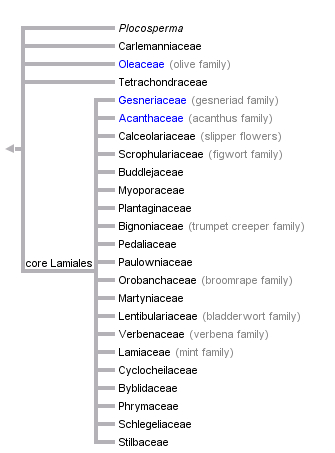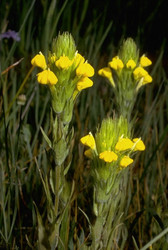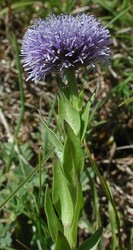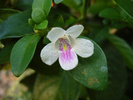Lamiales



This tree diagram shows the relationships between several groups of organisms.
The root of the current tree connects the organisms featured in this tree to their containing group and the rest of the Tree of Life. The basal branching point in the tree represents the ancestor of the other groups in the tree. This ancestor diversified over time into several descendent subgroups, which are represented as internal nodes and terminal taxa to the right.

You can click on the root to travel down the Tree of Life all the way to the root of all Life, and you can click on the names of descendent subgroups to travel up the Tree of Life all the way to individual species.
For more information on ToL tree formatting, please see Interpreting the Tree or Classification. To learn more about phylogenetic trees, please visit our Phylogenetic Biology pages.
close boxReferences
Albach, D. C., H. M. Meudt, and B. Oxelman. 2005. Piecing together the "new" Plantaginaceae. American Journal of Botany 92:297-315.
Albach, D. C., P. S. Soltis, D. E. Soltis, and R. G. Olmstead. 2001. Phylogenetic analysis of asterids based on sequences of four genes. Annals of the Missouri Botanical Garden 88:163-212.
Backlund, A. and B. Bremer, B. 1997. Phylogeny of Asteridae s. str. based on rbcL sequences, with particular reference to Dipsacales. Plant Systematics and Evolution 207:225-254.
Beardsley P. M. and R. G. Olmstead. 2002. Redefining Phrymaceae: the placement of Mimulus, tribe Mimuleae, and Phryma. American Journal of Botany 89:1093-1102.
Bremer, K., A. Backlund, B. Sennblad, U. Swenson, K. Andreasen, M. Hjertson, J. Lundberg, M. Backlund, and B. Bremer. 2001. A phylogenetic analysis of 100, genera and 50, families of euasterids based on morphological and molecular data with notes on possible higher level morphological synapomorphies. Plant Systematics and Evolution 229:137-169.
Bremer, B., K. Bremer, N. Heidari, P. Erixon, R. G. Olmstead, A. A. Anderberg, M. Källersjö, and E. Barkhordarian. 2002. Phylogenetics of asterids based on 3 coding and 3 non-coding chloroplast DNA markers and the utility of non-coding DNA at higher taxonomic levels. Molecular Phylogenetics and Evolution 24:274-301.
Olmstead, R. G., C. W. DePamphilis, A. D. Wolfe, N. D. Young, W. J. Elisons, and P. A. Reeves. 2001. Disintegration of the Scrophulariaceae. American Journal of Botany 88:348-361.
Olmstead, R. G., K.-J. Kim, R. K. Jansen, and S. J. Wagstaff. 2000. The phylogeny of the Asteridae sensu lato based on chloroplast ndhF gene sequences. Molecular Phylogenetics and Evolution 16:96-112.
Olmstead, R. G., H. Michaels, K. M. Scott, and J. D. Palmer. 1992. Monophyly of the Asteridae and identification of their major lineages inferred from DNA sequences of rbcL. Annals of the Missouri Botanical Garden 79:249-265.
Olmstead, R. G. and P. A. Reeves. 1995. Evidence for the polyphyly of the Scrophulariaceae based on chloroplast rbcL and ndhF sequences. Annals of the Missouri Botanical Garden 82:176-193.
Ryding, O. 1995. Pericarp structure and phylogeny of the Lamiaceae-Verbenaceae. Plant Systematics and Evolution 198:101-141.
Savolainen, V., M. F. Fay, D. C. Albach, A. Backlund, M. van der Bank, K. M. Cameron, S. A. Johnson, M. D. Lledó, J.-C. Pintaud, M. Powell, M. C. Sheahan, D. E. Soltis, P. S. Soltis, P. Weston, W. M. Whitten, K. J. Wurdack, and M. W. Chase. 2000. Phylogeny of the eudicots: a nearly complete familial analysis based on rbcl gene sequences. Kew Bulletin 55:257-309.
Schwarzbach, A. E. and L. A. McDade. 2002. Phylogenetic relationships of the mangrove family Avicenniaceae based on chloroplast and nuclear ribosomal DNA sequences. Systematic Botany 27:84-98.
Smith, J. F., K. D. Brown, C. L. Carroll, and D. S. Denton. 1997. Familial placement of Cyrtandromoea, Titanotrichum, and Sanango, three problematic genera of the Lamiales. Taxon 46:65-74.
Soltis, D. E., P. S. Soltis, M. W. Chase, M. E. Mort, D. C. Albach, M. Zanis, V. Savolainen, W. H. Hahn, S. B. Hoot, M. F. Fay, M. Axtell, S. M. Swensen, L. M. Prince, W. J. Kress, K. C. Nixon, and J. S. Farris. 2000. Angiosperm phylogeny inferred from 18S rDNA, rbcL, and atpB sequences. Botanical Journal of the Linnean Society 133:381-461.
Wagstaff S. J., L. Hickerson, R. Spangler, P. A. Reeves, and R. G. Olmstead. 1998. Phylogeny in Labiatae s. l., inferred from cpDNA sequences. Plant Systematics and Evolution 209:265-274.
Wagstaff, S. J. and R. G. Olmstead. 1997. Phylogeny of Labiatae and Verbenaceae inferred from rbcL sequences. Systematic Botany 22:165-179.
Wortley, A., P. Rudall, D. Harris, and R. Scotland. 2005. How much data are needed to resolve a difficult phylogeny? Case study in Lamiales. Systematic Biology 54(5):697-709.
Information on the Internet
- A Synoptical Classification of the Lamiales. Compiled by Richard Olmstead.
- International Carnivorous Plant Society.
- Carnivorous Plant Database.
Title Illustrations

| Scientific Name | Castilleja rubicundula ssp. lithospermoides |
|---|---|
| Location | Napa County, California, USA |
| Creator | Photograph by Robert Thomas and Margaret Orr |
| Specimen Condition | Live Specimen |
| Identified By | Doreen Smith |
| Source | Castilleja rubicundula ssp. lithospermoides; Cream Sacs |
| Source Collection | CalPhotos |
| Copyright |
© 1999 California Academy of Sciences

|
| Scientific Name | Bravaisia berlandieriana |
|---|---|
| Location | cultivated, South Miami, Florida, USA |
| Specimen Condition | Live Specimen |
| Source | Bravaisia berlandieriana |
| Source Collection | Flickr |
| Image Use |
 This media file is licensed under the Creative Commons Attribution License - Version 2.0. This media file is licensed under the Creative Commons Attribution License - Version 2.0.
|
| Copyright | © 2008 Scott Zona |
| Scientific Name | Globularia punctata |
|---|---|
| Location | Strangenberg, Haut-Rhin, Dép. Westhalten, France. |
| Specimen Condition | Live Specimen |
| Body Part | flowering shoot |
| Source | Globularia punctata (Globulariaceae) |
| Source Collection | Botanical Image Database |
| Copyright |
© 2001 University of Basel, Basel, Switzerland

|
About This Page
Page copyright © 2002
 Page: Tree of Life
Lamiales.
The TEXT of this page is licensed under the
Creative Commons Attribution-NonCommercial License - Version 3.0. Note that images and other media
featured on this page are each governed by their own license, and they may or may not be available
for reuse. Click on an image or a media link to access the media data window, which provides the
relevant licensing information. For the general terms and conditions of ToL material reuse and
redistribution, please see the Tree of Life Copyright
Policies.
Page: Tree of Life
Lamiales.
The TEXT of this page is licensed under the
Creative Commons Attribution-NonCommercial License - Version 3.0. Note that images and other media
featured on this page are each governed by their own license, and they may or may not be available
for reuse. Click on an image or a media link to access the media data window, which provides the
relevant licensing information. For the general terms and conditions of ToL material reuse and
redistribution, please see the Tree of Life Copyright
Policies.
Citing this page:
Tree of Life Web Project. 2002. Lamiales. Version 01 January 2002 (temporary). http://tolweb.org/Lamiales/20726/2002.01.01 in The Tree of Life Web Project, http://tolweb.org/











 Go to quick links
Go to quick search
Go to navigation for this section of the ToL site
Go to detailed links for the ToL site
Go to quick links
Go to quick search
Go to navigation for this section of the ToL site
Go to detailed links for the ToL site